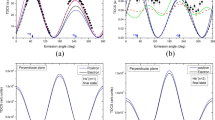Abstract
The 3-parameter model introduces 3 parameters (radius of a square nuclear potential well, the real part and the imaginary part of the nuclear potential depth) to describe the low energy behavior of the fusion cross-section for light nuclei. It has been justified by the experimental data from the National Nuclear Data Center (NNDC) for 3 major fusion reactions (d + T, d + D, and d + 3He). In the present paper this 3-parameter model has been extended to p+6Li fusion reaction. It agrees with the fusion cross-section data from NNDC again. Moreover it is able to calculate the astrophysical S-factor with an electron screening potential for p+6Li fusion reaction as well. As a development of the 3-parameter model, the necessary condition for a low energy resonant tunneling through Coulomb barrier is derived. It reveals further the possibility of resonant tunneling at very low energy for p+6Li system.



Similar content being viewed by others
References
H.A. Bethe, C.L. Critchfield, The formation of deuterons by proton combination. Phys. Rev. 54, 248 (1938)
B.H. Flowers, The theory of the T + D reaction. Proceedings of the Royal Society of London, Series A. Mathematical and Physical Sciences 204(1079), 503–513 (1951)
B.H. Duane, Fusion cross section theory, in Annual Report on CTR Technology, ed. by W.C. Wolkenhauer (Rep. BNWL-1685, Battelle Pacific Northwest Laboratory, Richland, 1972)
D.L. Book, NRL Plasma Formulary (Publ. 0084-4040, Rev., Naval Research Laboratory, Washington, D.C, 1987)
H.-S. Bosch, G.M. Gale, Improved formulas for fusion cross-sections and thermal reactivities. Nucl. Fusion 32, 611 (1992)
X.Z. Li, J. Tian, M.Y. Mei, C.X. Li, Sub-barrier fusion and selective resonant tunneling. Phys. Rev. C 61, 024610 (2000)
X.Z. Li, Nuclear fusion for nuclear fusion. Fusion Sci. Tech. 41, 63 (2002)
X.Z. Li, B. Liu, S. Chen, Q.M. Wei, H. Hora, Fusion cross-sections for inertial fusion energy. Laser Part. Beams 22, 469 (2004)
X.Z. Li, Q.M. Wei, B. Liu, A new simple formula for fusion cross-sections of light nuclei. Nucl. Fusion 48, 125003 (2008)
L.D. Landau, E.M. Lifshitz, Quantum Mechanics (Pergamon, Oxford, 1987), p. 572
C.L. Dunford, Data retrieved from the Cross Section Information Storage and Retrieval System (CSISRS) data base (Feb 27,1996); available on Internet (http://www.nndc.bnl.gov) (EXFORC0023001); plot produced using the code BNL 325. National Nuclear Data Center, Brookhaven National Laboratory
S. Engstler, G. Raimann, C. Angulo, U. Griefe, C. Rolfs, U. Schröder, E. Somorjai, B. Kirch, K. Langanke, Test for isotopic dependence of electron screening in fusion reactions. Phys. Lett. B 279, 20 (1992)
V.S. Vasilevsky, F. Arickx, J. Broeckhove, T.P. Kovalenko, A microscopic three-cluster model with nuclear polarization applied to the resonances of 7Be and the reaction 6Li(p, 3He)4He. Nucl. Phys. A 824, 37–57 (2009)
M. Abramowitz, I. A. Stegun (eds), Handbook of Mathematical Functions with Formulas, Graphs, and Mathematical Tables (National Bureau of Standards, 1972), p. 542 (10th printing)
Acknowledgments
This work is supported by The Ministry of Education (#20091770437), The Ministry of Science and Technology (Fundamental Research Division, #2009CB226113), Natural Science Foundation of China (#10475045) and Tsinghua University (Basic Research Fund (985-III)). Encouragement from Sood, D. D. and his IEAE colleagues since 1999 has been important in developing this model.
Author information
Authors and Affiliations
Corresponding author
Rights and permissions
About this article
Cite this article
Li, X.Z., Dong, Z.M. & Liang, C.L. Studies on p+6Li Fusion Reaction using 3-Parameter Model. J Fusion Energ 31, 432–436 (2012). https://doi.org/10.1007/s10894-011-9483-3
Published:
Issue Date:
DOI: https://doi.org/10.1007/s10894-011-9483-3




